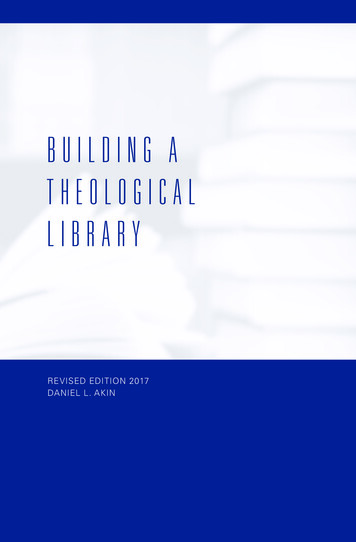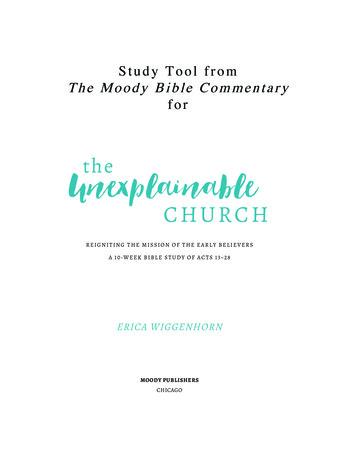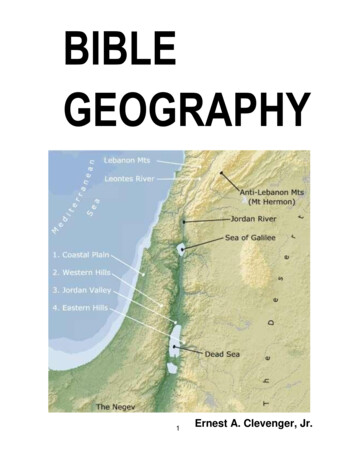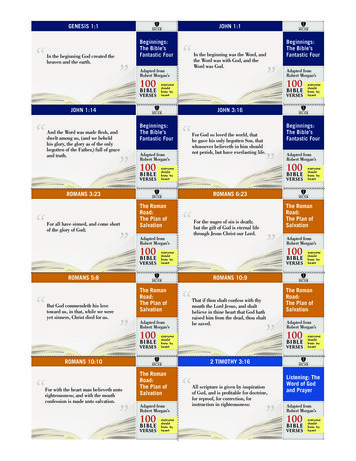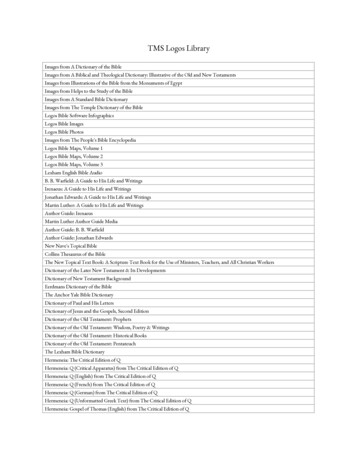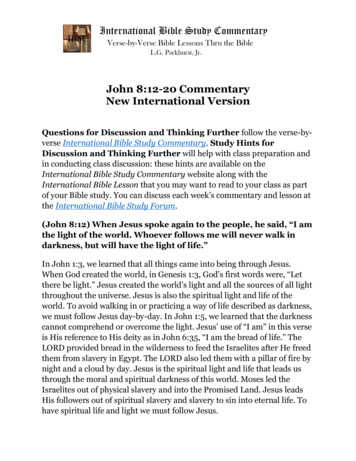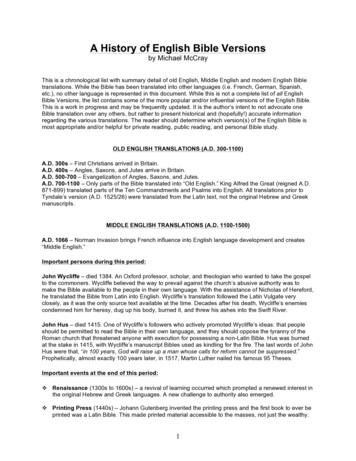
Transcription
Believers Church BibleCommentaryWriters Handbook
Believers Church Bible CommentaryEditorial CouncilDavid W. Baker, Brethren Churchdbaker@ashland.eduJohn R. Yeatts, Brethren in Christ Churchjyeatts@messiah.eduChristina Bucher, Church of the Brethrenbucherca@etown.eduGordon H. Matties (chair), Mennonite Brethren Churchgmatties@cmu.caDerek Suderman, Mennonite Church Canadadsuderma@uwaterloo.caJo-Ann A. Brant, Mennonite Church USAjoannab@goshen.eduDouglas B. Miller, Tabor College, Old Testament Editordougm@tabor.eduLoren L. Johns, Anabaptist Mennonite Biblical Seminary, New Testament Editorljohns@ambs.eduAmy Gingerich, MennoMedia, Executive DirectorAmyG@mennomedia.orgRevised 7/14; 10/18
Table of ContentsSeries Foreword1A Brief History of the BCBC Project2Philosophy, Structure, and Relationships of the BCBC Project41.2.3.4.5.6.Rationale and PurposeTarget ReadershipConceptThe Commentary WriterThe EditorsThe Editorial CouncilOverview of the Editorial Process10Guidelines for BCBC Writers121. Basics on the Manuscript2. Writing Suggestions3. Style MattersResponse Guide for Reader-Consultants21
Series ForewordThe Believers Church Bible Commentary series makes available a new tool for basicBible study. It is published for all who seek more fully to understand the originalmessage of Scripture and its meaning for today—Sunday school teachers, members ofBible study groups, students, pastors, and others. The series is based on theconviction that God is still speaking to all who will listen and that the Holy Spiritmakes the Word a living and authoritative guide for all who want to know and doGod’s will.The desire to help as wide a range of readers as possible has determined theapproach of the writers. Since no blocks of biblical text are provided, readers maycontinue to use the translation with which they are most familiar. The writers of theseries use the New Revised Standard Version and the New International Version on acomparative basis. They indicate which text they follow most closely and where theymake their own translations. The writers have not worked alone, but in consultationwith select counselors, the series’ editors, and the Editorial Council.Every volume illuminates the Scriptures; provides necessary theological,sociological, and ethical meanings; and in general makes “the rough places plain.”Critical issues are not avoided, but neither are they moved into the foreground asdebates among scholars. Each section offers ”Explanatory Notes,” followed byfocused articles, “The Text in Biblical Context” and “The Text in the Life of theChurch.” This commentary aids the interpretive process but does not try to supersedethe authority of the Word and Spirit as discerned in the gathered church.The term believers church emerged in the mid-twentieth century to defineChristian groups with direct or indirect connections to the Radical Reformation, adistinctive faith expression that arose in Europe during the sixteenth century. Thesebelievers were concerned that the church be voluntary and not be aligned withpolitical government. Believers church has come to represent an identifiabletradition of beliefs and practices that includes believers (adult) baptism; a voluntaryfellowship that practices church discipline, mutual aid, and service; belief in thepower of love in all relationships; and a willingness to follow Christ by embracing hiscross as a way of life. In recent decades the term has sometimes been applied tochurch communities informed by Anabaptism, evangelicalism, or pietism, such asBrethren Church, Brethren in Christ Church, Church of the Brethren, MennoniteBrethren, and Mennonites, as well as similar groups. The writers chosen for theseries speak from within this tradition.Believers church people have always been known for their emphasis onobedience to the simple meaning of Scripture. Because of this, they do not have along history of deep historical-critical biblical scholarship. This series attempts to befaithful to the Scriptures while also taking archaeology and current biblical studiesseriously. Doing this means that at many points the writers will not differ greatlyfrom interpretations that can be found in many other good commentaries. Yet thesewriters share basic convictions about Christ, the church and its mission, God andhistory, human nature, the Christian life, and other doctrines. These presuppositionsdo shape a writer’s interpretation of Scripture. Thus this series, like all othercommentaries, stands within a specific historical church tradition.Many in this stream of the church have expressed a need for help in Bible study.This is justification enough to produce the Believers Church Bible Commentary.Nevertheless, the Holy Spirit is not bound to any tradition. May this series be aninstrument in breaking down walls between Christians in North America and aroundthe world, bringing new joy in obedience through a fuller understanding of the Word.Page 1Rev. 9/10; 10/18
A Brief History of the BCBC ProjectThe idea of a commentary produced by the believers church came from Ben Cutrell ofMennonite Publishing House in 1977. This idea was tested with the MennonitePublication Board, the General Board, and the other program boards of theMennonite Church later that year. It was also tested in a combined meeting of InterMennonite seminaries and college Bible faculties the same year. Later that year acomprehensive proposal was prepared which promoted the idea of twelve volumes of4,390 pages and a budget of one million dollars. The proposal was not accepted.In the fall of 1978 the Mennonite Publication Board accepted a more modestproposal in which writers would be remunerated through a regular royaltyarrangement and it was not assumed all books of the Bible would be covered. An adhoc committee met in early 1979 and worked further on the proposal. This wasfollowed by the publication board deciding to invite other Anabaptist groups in thebelievers church tradition to join in and make it an inter-Mennonite project.On June 2, 1980, a Commentary Selection Committee met. Persons presentcame from the Mennonite Church, General Conference Mennonite Church, Brethrenin Christ Church, Church of the Brethren, and Mennonite Brethren Church, alongwith some persons from Mennonite Publishing House. They worked onadministrative plans for the commentary project. On December 12, 1980,representatives from the five denominations met again and agreed that there shouldbe an Old Testament Editor, a New Testament Editor, and an Editorial Council withone representative from each of the participating denominations. Herald Press wouldbe the publisher. Much of the success of this meeting came as a result of the goodwork Ben Cutrell had done on the project since the prior meeting. Thereafter theEditorial Council has met yearly.In 1981 the Editorial Council agreed on the name, Believers Church BibleCommentary. The Editorial Council outlined its task, defined the work of the Editors,agreed writers should have consultants, and Herald Press would assume financialresponsibility and carry out the details of publishing the series. About sixty potentialwriters were identified. Elmer A. Martens was appointed OT Editor and served asEditor from 1981 to 2003.In 1982 Howard H. Charles was present as the NT Editor. A draft of a commonintroduction was reviewed. Elmer Martens had spent an extended period of time atUnion Theological Seminary in Richmond, Virginia, researching commentaries andcame to the meeting with a proposal about how the Believers Church BibleCommentary should be written. Unique to this proposal were three major elements:Explanatory Notes, Text in Biblical Context, and Text in the Life of the Church.Martens was assigned the task of writing the Jeremiah commentary. The EditorialCouncil reviewed guidelines for writers and assigned books to some writers toprepare samples for review. It was agreed the writing should be on the twelfth gradelevel for use across the church by pastors, Sunday school teachers, and small Biblestudy group leaders.In 1983 there was more clarification of the guidelines for writers. In 1984 itwas agreed that 250 to 325 pages was to be the target length of each volume.Throughout the process the Editorial Council agreed critical issues should be kept inthe background.Page 2
In 1986, Jeremiah, the first commentary of the series, was published. In manyways this commentary became a guide for other writers in terms of layout,readability, essays, etc. Allen Guenther served as Editor of this one volume. TheEditorial Council stated, “this commentary series focuses attention on the canonicaltext rather than the pre-text of sources. . . . The exposition should proceed withnontechnical language rather than the scholarly shorthand.” It was noted Text in theLife of the Church should include pastoral concerns, history of interpretation, andapplication in the life of the church. “The whole of church history is to be taken intoaccount, with focus on important moments in understanding the text, especiallyAnabaptist and discipleship understandings.” Other samples were assigned and/orreviewed, and writers were asked to write their assigned commentary.In 1987 Paul M. Zehr was asked to chair the Editorial Council in the place ofHarold Bauman, who had ably served as Chair from the beginning. In 1989 HowardH. Charles asked to be replaced as NT Editor due to health reasons and Willard M.Swartley was selected as NT Editor and served from 1989 to 2001.In 1990 a representative from the Brethren Church joined the EditorialCouncil, giving the project six denominations (Mennonite Church, MennoniteBrethren Church, General Conference Mennonite Church, Brethren in Christ Church,Church of the Brethren, and Brethren Church). In 1991 the Matthew commentary,written by Richard B. Gardner, was published.Between 1991 and 2004 a total of 17 volumes were published (8 OT, 9 NT).Genesis was translated into Russian. With the publication of Exodus (2000),Ephesians (2002), and Romans (2004), the reading level of the commentaries movedhigher. The Editorial Council agreed the reading level should move from grade twelveto first and second year college level.In 1992, through the generosity of a Schowalter Foundation grant, a specialBCBC workshop for writers was held at Associated Mennonite Biblical Seminary inElkhart, Indiana. Resource persons were Willard Swartley, Elmer Martens, KatieFunk Wiebe, C. J. Dyck, and S. David Garber. Attention was given to biblicalinterpretation issues, Text in Biblical Context, and Text in the Life of the Church aswell as writing style. In 1996 and 1997, seminars were held across the churchpromoting the commentary series.In 2002 Willard Swartley asked to be relieved of the NT Editor work due tohealth concerns. Gordon Zerbe, from Canadian Mennonite University in Winnipeg,was appointed NT Editor, and in 2006 Loren Johns of Associated Mennonite BiblicalSeminary replaced him in this role. In 2003 Elmer Martens asked to be replaced, andDouglas B. Miller of Tabor College was appointed OT Editor. There has been somechange in Editorial Council members in recent years. With the merger of theMennonite Church and the General Conference Mennonite Church and the resultantchange to Mennonite Church Canada and Mennonite Church USA, there is now onerepresentative from each of these two denominations. The names of the Editors andEditorial Council members are listed in each volume of the BCBC that is published.At its 2004 meeting the Editorial Council and Herald Press honored Elmer Martensand Willard Swartley for their work on the commentary series over the years. In2006, the Council celebrated the series’ twentieth volume (10 from each testament)and renewed its commitment to bring the entire project to completion.Reviews of the commentaries have been quite positive both from within thechurch and from the larger scholarly world. Herald Press also receives strong positivefeedback from the church on the published volumes.Paul M. Zehr11/04; rev. 11/06; 9/10Page 3
Philosophy, Structure, and Relationshipsof the BCBC Project1.Rationale and PurposeAs a people of the Bible, members of the believers church claim that our distinctiveunderstanding of Christian faith and life flows from the Scriptures. Consequently aBible commentary within this tradition will move to support this claim.Within the believers church tradition the church is envisioned as a voluntarycommunity of love. It consists of persons claimed by Christ’s love who committhemselves to follow their Master in worship and discipleship, in fellowship andnurture, in separation from the world and the obedient response to “go into all theworld and make disciples of all nations.”The ethical vision of the believers church grows out of an active love. Itincludes sharing possessions to meet the needs of others. It assumes a readiness toserve. It places high value on human life. It is rooted in the reconciling work of Godand issues in the call to be a reconciling people.The believers church perspective on the Bible obligates every Christian to studythe Scriptures for the purpose of meeting God in them and to discover and practicethe will of God. Such study will be individual and corporate. Insights are shared withthe body, resulting in obedience to the truth. Christians search the Scriptures awarethat God’s truth cannot be plumbed. Consequently, they bring to the Bible an attitudeof expectation and openness. The commentary, therefore, is to encourage furtherreflection and study. This will occur implicitly, for example, through narratives offaithful living and raising questions, and more explicitly through such means assuggestions for fruitful issues to pursue. The commentary is intended to generateinterest, inquisitiveness, and excitement toward further understanding andapplication of the biblical message.The rationale for the proposed commentary springs from these contributionsand perspectives of the believers church regarding the church and its mission, ethics,and the Scriptures.1.1Therefore the purpose of the Believers Church Bible Commentary is to:1.1.1 Clarify and strengthen the believers church understanding of its biblicalfoundation.1.1.2 Pass on the heritage of faith to succeeding generations. The productionof such a commentary is timely inasmuch as there are now sufficientmature Bible teachers among us to complete the task.1.1.3 Share the believers church perspectives on the essential teachings ofScripture and the resultant faith responses with the wider church. Whilethe intention is not to search the Scriptures for themes that arecharacteristic of the believers church tradition, there is a felt need tohighlight themes that are central yet do not receive sufficient orbalanced treatment in the commentaries of other Christian traditions.These include the believers concept of the people of God, the peace andreconciliation theme, and the call to mission and service as an integralpart of the Scriptures (“Guidelines,” 3rd revision, 1983).Page 4
1.22.At the commentary workshop in Elkhart (1992) the following distinctives ofthese commentaries were named:1.2.1 They stand in the Anabaptist tradition. The series is to be a witness tothe Anabaptist viewpoint in tenor as well as in “topics” (people of God,community, discipleship, peace, service/mission, etc.), but should not beparochially “in-house” (see the Series Foreword).1.2.2 They reflect a community hermeneutic. Input is given by lay readers,peer readers, and especially the Editorial Council, which representsvarious denominations and points of view.1.2.3 They place emphasis on theology.1.2.4 Their level of writing is popular.1.2.5 They are written for the church.Target ReadershipThe commentary should be written at a college freshman reading level. The expectedprimary users of this commentary are:2.12.22.32.42.52.62.73.3.1Leaders and teachers of believers church congregations in North America. Thiswould include, for example, pastors, teachers of Sunday school classes, Biblestudy
Believers Church Bible Commentary Editorial Council David W. Baker, Brethren Church dbaker@ashland.edu John R. Yeatts, Brethren in Christ Church jyeatts@messiah.edu Christina Bucher, Church of the Brethren bucherca@etown.edu Gordon H. Matties (chair), Mennonite Brethren Church gmatties@cmu.ca Derek Suderman, Mennonite Church Canada
